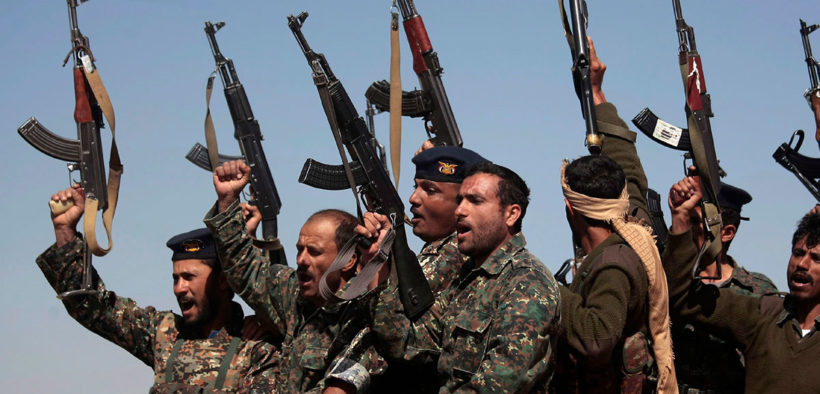“The solution to the conflict in Yemen…

 Hardeep Puri
Hardeep Puri
…cannot be left in the hands of the conflict’s willful perpetuators. A solution is urgently needed. The US administration under President Trump and the UN Secretary-General Antonio Guterres must spearhead a new initiative to bring all of the warring sides to the negotiating table. An immediate cessation of hostilities is required in order to provide long overdue assistance and relief in what is one of the greatest humanitarian crises of our time. The route to sustained stability requires active engagement of all stakeholders in the conflict and a complete abandonment of the ‘no negotiations’ stance that has all too often plagued the conflict.
The oscillating role of the US in Yemen – from backing the governments of former President Ali Abdullah Saleh and current President Abd Rabbuh Mansur Hadi to then supporting the Houthis and, finally, backing the Saudi-led military campaign against the Houthis – has cemented the leading world power as the necessary but absent leader in the peace process. Although US involvement in the conflict was initiated by its misguided mission to subdue the threat of Al Qaeda in the Arabian Peninsula (AQAP), its promiscuous approach to alliances among the warring parties in Yemen means that, ultimately, the US must be heavily involved in the negotiations.
The unlawful intervention of Saudi Arabia and its allies in Yemen – a blatant violation of international law, and a catalyst for the significant civilian death toll – should be a trigger for swift action by the UN Security Council. The Council has demonstrated its failure to date in this regard, but still has ample opportunity to prove its effectiveness.
A new US administration and a new UN Secretary-General should not be seen as tabulae rasae. According to the Global Centre for the Responsibility to Protect, to date, well over 4,000 civilians have been killed and more than 3.3 million displaced as a result of the violence in Yemen. The burden of responsibility for the fate of those remaining alive does not disappear with the change in leadership in either the US or the UN. When faced with such numbers, all roads are eliminated, except for the one that serves the cause of peace. The US and UN must pave the way to this end goal.”
» Hardeep Puri is a former Indian diplomat who served as Permanent Representative of India to the UN in Geneva and also in New York. He is the author of Perilous Interventions: The Security Council and the Politics of Chaos.
Kayhan Barzegar
… is to initiate an immediate ceasefire with the help of the international community, and start the peace negotiations in a multilateral context in order to establish an inclusive government in the war-torn country.
The Yemeni crisis is an internal, multi-party conflict that started after the Arab Spring in 2011. It is rooted in the expectations of the people and different political factions for change, and growing opposition to the corrupt regime of President Ali Abdullah Saleh. Subsequently, the failure of Abd Rabbuh Mansur Hadi, Saleh’s Deputy, to adjust the political transition to the country’s new political and social realities led to intense political divisions within Yemen.
The turning point in the Yemeni crisis, however, can be attributed to Saudi Arabia’s intervention through air raids, which began in March 2015 in support of forces loyal to the incumbent regime. This intervention intensified the conflict and pushed the country toward civil war. Yemen has since been divided into two parts – Northern (Sanaa) and Southern (Aden), governed respectively by Shiite Houthis (officially named Ansar Allah) and forces loyal to Mansur Hadi. The chaos and instability created in Yemen have in turn proved to be fertile ground for Al Qaeda (AQAP) and ISIS to expand their operations from the war-torn country.
Some inaccurately speculate that the conflict in Yemen is mostly the result of a proxy geopolitical war between Iran and Saudi Arabia in the broader Middle East. However, Iran’s role and influence in the conflict have been greatly exaggerated. To be sure, Iran supports the institutionalization of the Houthis’ place in the political equation in Yemen, according to their share of population. In reality, Iran’s role manifests itself more in the form of political, media and humanitarian support rather than military aid. This is to be contrasted with Riyadh’s robust engagement in the Yemeni conflict.
There are two perspectives among Iranian strategists in respect of the significance of Yemen. The first sees Yemen as an important Arab country in the Arabian Peninsula, with significant geostrategic importance – especially given that it gives Iran access to the Mediterranean coast, reaching Syria and Lebanon through the Bab al-Mandab Strait. On this logic, a friendly government in Yemen will bolster Iran’s strategic influence in the region. The argument holds, therefore, that Iran should assume a proactive policy in order to influence the future structure of the government in Yemen.
The second, more dominant perspective accepts the vital and traditional interests of Saudi Arabia in Yemen, but based on the principles of Iranian regional policy – that is, to support the demands of the people, and especially of Shiite groups in the region who have traditionally been excluded from meaningful political participation and power-sharing, and to seek the establishment of an inclusive government, comprised of all political factions – Sunni and Shiite alike – in the country. In fact, the government of President Hassan Rouhani has preferred to take a low engagement policy in Yemen in order to avoid any possible conflict with Saudi Arabia that could lead to further regional instability and a more robust US presence in the region. To this end, the foreign minister of Iran, Mohammad Javad Zarif, has repeatedly called for dialogue and proposed a peace plan to solve the Yemeni crisis.
The reality is that the military intervention by Saudi Arabia has complicated the internal conflict in Yemen. Riyadh’s main justification for bombing Yemen is to restore the balance of power in the country – out of Iran’s influence and in favour of Saudi Arabia. This intervention was welcomed by the US, the UK, France and Saudi Arabia’s regional allies. Yet, despite all of the intelligence and military support provided by these countries, Saudi Arabia has not yet achieved its goal of controlling Yemen or taming it to its advantage. The main reason for this failure is that Riyadh ignores the fact that this is a multi-layered conflict, and that the Houthis’ continued resistance is based on deep-rooted aspirations.
The conflict in Yemen can be resolved. A key move to this end involves Western countries ending their support of the Saudi military intervention, and also increased pressure on the Saudi monarchy to understand the necessity of change in the country. Riyadh must accept the fact that Yemen cannot return to its pre-Arab Spring form and reality.”
» Kayhan Barzegar is Director of the Institute for Middle East Strategic Studies in Tehran, Iran, and the Chair of the Department of Political Science and International Relations in the Science and Research Branch of Azad University.
Charles Schmitz
…is to help foster a Yemeni state with sufficient legitimacy to permit a sustained rebuilding process. An inclusive regional agreement may be the best path to do so because Yemeni leaders do not trust one another. Of course, regional leaders do not agree either, but there may be no other path to peace.
The Saudi-backed coalition argues that Abd Rabbuh Mansur Hadi is the legitimate leader of Yemen, and that he should return to the capital Sanaa by force if necessary. Hadi was the vice-president of Ali Abdullah Saleh, the longtime ruler of Yemen who resigned under pressure from the Arab Spring protests and from the Gulf states worried about Yemen’s stability. In the eyes of Hadi and his Gulf backers, peace begins only with the surrender of the Houthis and the Saleh forces in Sanaa and the reinstallation of the Hadi government (now in Aden).
On the other side, the Houthis, backed by Iran, argue that a negotiated settlement should begin with the formation of a national reconciliation government that includes the Houthis, Saleh and those aligned with Hadi. The national reconciliation government would oversee military disengagement and the rebuilding of a single national military under its command. Peace would begin with a political settlement and then proceed to military disengagement.
Most observers agree that there is no military solution to the conflict. After almost two years of war, the Saudi-backed forces have failed to penetrate the populous western highlands of Yemen where the capital is located – although they have absolute air superiority and have blockaded all of Yemen’s ports. Even if the Saudi-backed coalition succeeds in retaking the capital by force, those aligned with Saleh and the Houthis will retain control of much of the highlands, and will not trust the Hadi government in Sanaa. Yemen would therefore remain ungovernable.
A regional settlement that includes Russia and Iran on the side of the Houthis and Saleh, and the US and Gulf states on the Hadi side, is one way to give enough confidence to local actors to the effect that peace is possible.
For their part, the Houthis and Saleh have shown no willingness to negotiate a political settlement that the other parties in the country can trust, while these same parties see the Houthis and Saleh as dictators who rule by force of arms. Bref, if there is no military solution, there appears to be no peaceful solution either.
The Trump administration will likely agree with the Saudis to continue with the military pressure, but it is not clear that military pressure can convince the Houthis and Saleh to negotiate a real settlement. The country and economy are on a wartime footing, and those profiting from war are in command on both sides. A regional settlement that includes Russia and Iran on the side of the Houthis and Saleh, and the US and Gulf states on the Hadi side, is one way to give enough confidence to local actors to the effect that peace is possible. The inclusion of Iran and Russia would give the Houthis and Saleh some confidence that their interests will be preserved, and allow them to relinquish their military advantage. For Iran, Yemen is not a vital security interest but rather a card to play in their struggle with the Saudis. The Iranians may therefore not be disinclined to negotiate.”
» Charles Schmitz is a professor at Towson University, and vice-president of the American Institute for Yemeni Studies.











